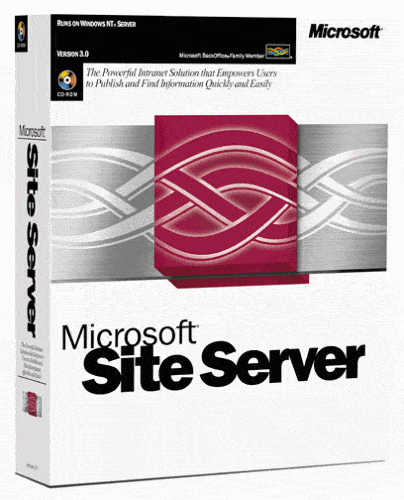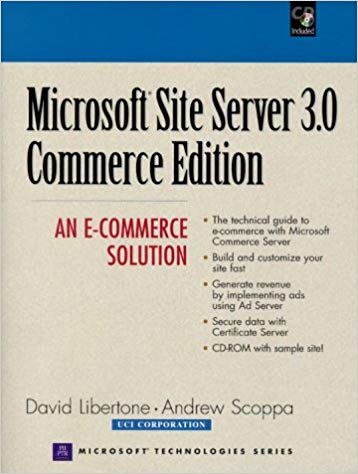Definition of Microsoft Site Server in The Network Encyclopedia.
What is Microsoft Site Server?
Microsoft Site Server was a comprehensive Internet server for end-to-end management of enterprise-level Internet and intranet sites. First released in 1996, was Microsoft’s solution to the growing difficulty of managing complex websites which included multiple technologies, such as user management and authentication/authorization, content management, analysis, and indexing and search.

Using Microsoft Site Server version 3, organizations can easily publish information to the Internet or corporate intranets by providing content authors with a structured content submission, posting, and approval process managed by site administrators and site editors.
Site Server lets users search for information from diverse sources that include internal and external Web sites, network file servers, Microsoft SQL Server databases and other ODBC-compliant databases, and Microsoft Exchange Server public folders.
Using Site Server, companies can deliver information to users through personalized Web pages, channels, and direct e-mail. Site Server administrators can analyze site usage to plan and troubleshoot the structure and effectiveness of their sites.
Site Server is optimized to run with Microsoft Windows NT and Internet Information Services (IIS) and can be used in heterogeneous networking environments for clients running on any platform as long as they have a standard Web browser such as Microsoft Internet Explorer. Site Server tools cover the full range of Web site development needs:
- Publishing: Site Server’s comprehensive publishing solution comprising a set of tools for managing site content. Content management tools let multiple content authors submit, tag, and edit content using a drag-and-drop Web interface. Content deployment tools let site administrators place Web content on staging servers for review and then securely and easily deploy it to production Web servers.
- Delivery: Site Server’s powerful search tool lets users search across Internet and intranet Web sites, files, databases, and Exchange servers. Sites can deliver personalized content to users, including personalized mailings, using the Direct Mailer tool. Active Channel Multicaster, based on multicast technology, delivers information using push technologies. Active Channel Server can be used to manage and schedule the delivery of information using channels. Users can also self-manage subscription sites.
- Analysis: Site Server provides tools for analyzing Web site usage and structure, and for importing Web server log files into a database from all popular Web servers (including IIS, Netscape, Apache, Lotus Domino, and Real Audio servers). You can also import data from sources other than Web server log files using Custom Import and then generate Web site activity reports based on that data using Report Writer and its 46 predefined report styles. You can use Content Analyzer to help you visualize the structure of Web sites. The powerful searching and analysis tools of Content Analyzer let you gain insight into how a site is being used.
Before implementing Site Server
Before you implement Site Server, you should do the following:
- Sketch out the hierarchy of your organization with the common names of the various departments and sections, personnel classifications, and job titles.
- List the content types you plan to use in building your site, and plan the attributes you will use to describe each type of content.
- Use the makecm.vbs script included with Site Server to create your content stores with their various content types, directories, and attributes.
Knowledge Manager
Knowledge Manager is a component of Microsoft Site Server that makes it easy for visitors to your site to find information and receive updates when information is added or changed. Knowledge Manager enables users to:
- Search for information by entering a word or a phrase.
- Browse predefined categories of information (similar to Yahoo! categories).
- View personal knowledge briefs, which are summaries of information on a specific topic that consist of Uniform Resource Locators (URLs) or saved searches. Users can set up their own personal briefs (called My Briefs) or subscribe to briefs created by experts in the organization. They can receive updates by e-mail, from a briefing channel, or by revisiting the Web page.
- Create Shared Briefs for sharing information with colleagues.
- View the Channel Center, which lists available channels.
Site administrator?
In Microsoft Site Server, Site Administrator is a user who is responsible for building and managing the Web site infrastructure and administering the overall Web publishing process. Site administrators ensure that content has been properly submitted by content authors and approved by site editors before it is deployed to destination Web servers.
Site administrators usually stage content on one or more staging servers so that it can be thoroughly tested before final deployment to one or many destination Web servers on the corporate intranet or the Internet.
Microsoft Site Server, Commerce Edition
Commerce Edition is an integrated Internet server built on Microsoft Site Server for Internet e-commerce. Using Microsoft Site Server, Commerce Edition, businesses can create and manage cost-effective e-commerce sites and applications, produce targeted online advertising and marketing, and participate in personalized promotion schemes.
Companies can conduct business online securely using order capture, management, and routing functions. Site Server, Commerce Edition, integrates easily into existing inventory, accounting, and electronic data interchange (EDI) systems and includes tools for analyzing customer and partner usage information.

In addition to the publishing, delivery, and analysis features of Site Server, Commerce Edition, version 3 includes such e-commerce features as
- Ad Server: For deploying online advertisements. Ad Server supports targeted delivery, scheduled management, and exposure limits.
- Buy Now: Formats product information and order forms in various ways (including for online ads).
- Commerce Interchange Pipeline: Enables interchange of structured business information using the Internet or existing EDI systems.
- Microsoft Market: A sample site with reference code for intranet-based corporate purchasing applications that use authenticated requisitions, purchase order workflow and approval mechanisms, a procurement catalog schema, and multiple purchase order output types.
- Dynamic Promotion: Enables development of advertising campaigns and product promotions based on the preferences and purchasing history of customers and partners.
- Order Processing Pipeline: For managing orders based on specified business rules.
Microsoft Site Server Express
Site Server Express was an Internet application for analyzing and reporting on the structure and functionality of Web sites hosted using Internet Information Services (IIS). Microsoft Site Server Express, which is included in the Microsoft Windows NT Option Pack, offers a subset of the functionality included with Microsoft Site Server, including the following tools and utilities:
- Content Analyzer: For visual analysis of sites in the form of a Web map
- Usage Import: Imports IIS logs for generating reports using Report Writer
- Report Writer: Analyzes imported IIS logs and generates reports about the users and organizations that have visited your site and about the requests made at your site
- Posting Acceptor: Enables users to publish Web content to IIS using the HTTP Post method described in Request for Comments (RFC) 1867
Usage Import
Usage Import is a tool included with Microsoft Site Server and Microsoft Site Server Express for importing log files from a Web server. Usage Import can read various log file formats, which are Site Server, W3C Extended, Microsoft Internet Information Server (IIS), and NCSA Common. To use Usage Import, you select the desired log files and start the importing process. The importing process will import the log file data into the Site Server database. You can generate reports and analyze these imported logs by using Report Writer.
Personalization and Membership servers?
Personalization and Membership servers are related components of Microsoft Site Server that enable Web site administrators to personalize content for site visitors and provide secure content based on site membership. Features of the Personalization and Membership servers include the following:
- Personalized content suited to individual visitors’ needs. Site administrators can build rules governing personalized content and store user profiles in the Membership Directory.
- Members-only areas on a site with controlled access for users. Site administrators can register users, protect and share their data, verify users’ identities, and control access to sites. User information is stored in a Lightweight Directory Access Protocol (LDAP) directory based on Microsoft SQL Server.
- Direct mail for delivering personalized content to site visitors through scheduled e-mail based on their site usage patterns.
How It Works
Membership Authentication on the Personalization and Membership servers builds on Microsoft Windows NT security by letting administrators store user accounts and group permissions in the Site Server Membership Directory. Access to Web content is controlled by granting users and groups permissions on Web content using the same Windows Explorer method that Windows NT and Internet Information Services (IIS) administrators use.
By storing user and group accounts in the Membership Directory, you can enable sites to scale beyond the capabilities of the Windows NT Security Account Manager. In other words, instead of managing tens of thousands of accounts using the Windows NT domain model, you can use Personalization and Membership servers to manage millions of user accounts. This is particularly important if a cookie account and a user profile must be created for every user visiting the site.
Tools are also included for creating registration pages to handle creating new user accounts in the Membership Directory, adding users to groups, and upgrading cookie users to secured accounts. You can manage membership by using Microsoft Management Console (MMC) or through Web-based Administration (WebAdmin).
Content Analyzer (Site Server Express)
Content Analyzer is a tool included with Microsoft Site Server and Microsoft Site Server Express that lets Web server administrators perform content analysis and link management of Web sites. Content Analyzer can visually display the structure and integrity of a site in the form of a diagram called a Web map.
Web maps allow administrators to visually examine the structure of a site and quickly identify problems, such as loops and broken links. Web maps display various Web content items using different icons and can use a variety of colors to convey different kinds of information.
You can also use Content Analyzer to search Web maps for various kinds of information using predefined Quick Searches. Once you find an item of interest on a Web map, you can open your Web page editing tool directly from the Web map. You can also export Web map information into a database or spreadsheet file for further analysis.
Content Analyzer can also generate predefined site reports you can use to identify broken links and analyze the structure of Web sites. These site reports can be generated in Hypertext Markup Language (HTML) format for easy reading and evaluation, and can identify changes to the content of a site, broken links, and other information.
Web Map
A Web map is a graphic display generated by Content Analyzer (a tool included with Microsoft Site Server and Microsoft Site Server Express) that allows Web server administrators to view the structure and integrity of their Web sites. Web maps can display all or selected portions of a site, including Hypertext Markup Language (HTML) files, graphics files, Java applets, and any other type of object. Administrators can use the Web map to determine the properties of any object in the site, such as the date when the object was last modified or its file size.
Web maps can be displayed in two different views:
- Tree view: Displays a hierarchical picture of the objects in the site. This view is similar to the left pane of Windows Explorer.
- Hyperbolic view: Displays the objects in the site in a dynamic nonlinear form that you can drag and manipulate to change its size and shape.
Report Writer
Report Writer is a tool included with Microsoft Site Server and Microsoft Site Server Express that can take Web server log files that have been imported using the Usage Import tool and generate summary or detail reports on several topics, including the following:
- Bandwidth use due to server hits
- Browser and operating system used by clients
- Geographical distribution of clients
- Hit statistics
- Most and least frequently requested documents